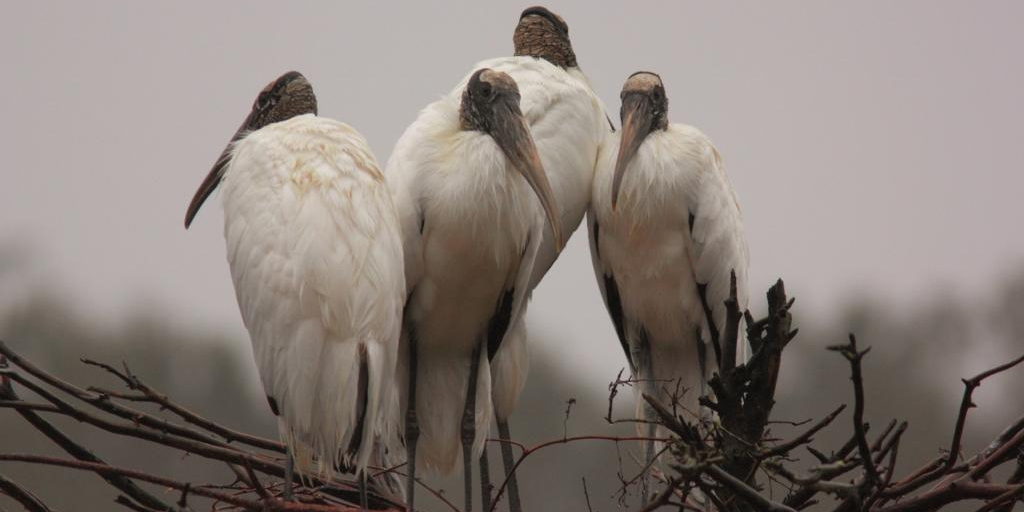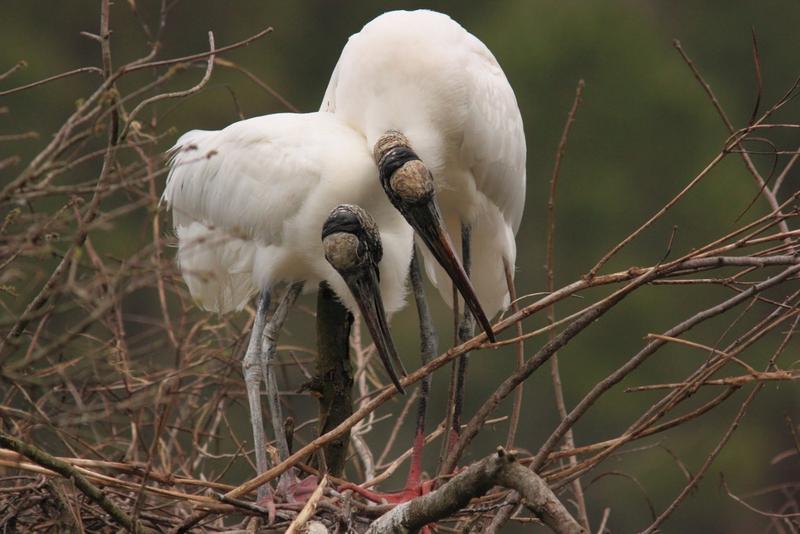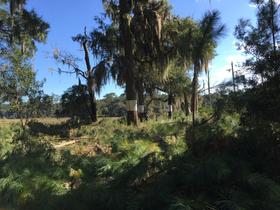Georgia Scientists Get Creative To Protect A Threatened Bird

Wood storks roosting at Harris Neck National Wildlife Refuge on the Georgia coast.
U.S. Fish and Wildlife Service Southeast Region / flickr.com/usfwssoutheast/
Sometimes what scientists need to protect a threatened species is a chainsaw, some roofing material and a little bit of creativity. On the Georgia coast, the Department of Natural Resources is channeling MacGyver to help out a big, gawky, bald-headed bird.
It’s a bird that hasn’t always nested in Georgia, but now that it does, scientists are working to protect it.
Wood Storks
Wood storks aren’t exactly conventionally beautiful.
“They’ve got virtually no feathers on their neck or head, except when they’re very young,” says Tim Keyes, a biologist with the DNR. “They’ve got long sort of drooping bills. And as adults, they have kind of a black scaly look to their head and neck.”
Their feathers are mostly white. Their bodies are sort of football shaped, and they’re tall – over three feet.
“In flight, from a distance, they’re actually quite attractive. The closer you get, the less attractive they appear,” says Keyes, laughing.
Keyes and a group from the DNR recently went to Sapelo Island, to a place where the birds nest. Dozens of storks gather in a few big old oak trees here every year to raise their chicks. Storks typically nest in trees that are surrounded by water, which protects them from raccoons. But this spot on Sapelo Island isn’t safe, and raccoons can wreck a wood stork colony.
“It’s really a horrible thing to watch,” says Chris Depkin with the DNR. “Because the raccoons are in the top of the tree, and they’ll just run from nest to nest, and they’ll basically just kill chicks, and take a little nibble, and then they go over and kill another one, and kill another one. In the morning, it’s just really quite a tragic scene.”
To keep raccoons from getting up the trees and to the nests, the DNR cuts down nearby saplings and wraps wide shiny sheets of metal, usually used for roofing, around the trunks of the oaks, which are left standing. The metal keeps raccoons from climbing the oaks, and the other trees, the ones that were cut down, can no longer serve as bridges from the ground up to the nests.
Refugees From The Everglades

Raccoons are just one of the dangers wood storks have had to contend with. The birds, which are threatened, used to only nest in the Everglades in Florida.
“If you read some of the early ornithologists’ descriptions of wood storks, it’s really fun,” says Keyes. “I mean they talk about wading through the primordial swamps and if you’re lucky you might catch a glimpse of the rare and elusive wood stork.”
Human development degraded their original habitat, and Keyes says there were major colony failures. But they didn’t die out.
“And now in Florida they nest in drainage ponds at highway interchanges and backyard neighborhood ponds and things like that,” he says.

Since the mid-1960s, they’ve also come to nest in Georgia. About a quarter of wood storks now nest in the state, either on the coast or in the southwest corner. South Carolina has about equal numbers, says Keyes.
The wood stork population still isn’t anywhere near the size scientists think it once was, but a few years ago, the U.S. Fish and Wildlife Service moved the species’ designation from “endangered” up to “threatened.”
When Keyes and Depkin and the rest of the crew are done, what looked like a crazy weedy thicket is pretty cleared out. The young trees that were cut down make a piney mat on the ground. And the oak trees look fancy in their sheets of silver metal, like a raccoon-proof art installation.
Wood storks usually start nesting here in late February or early March.
9(MDAxODM0MDY4MDEyMTY4NDA3MzI3YjkzMw004))





